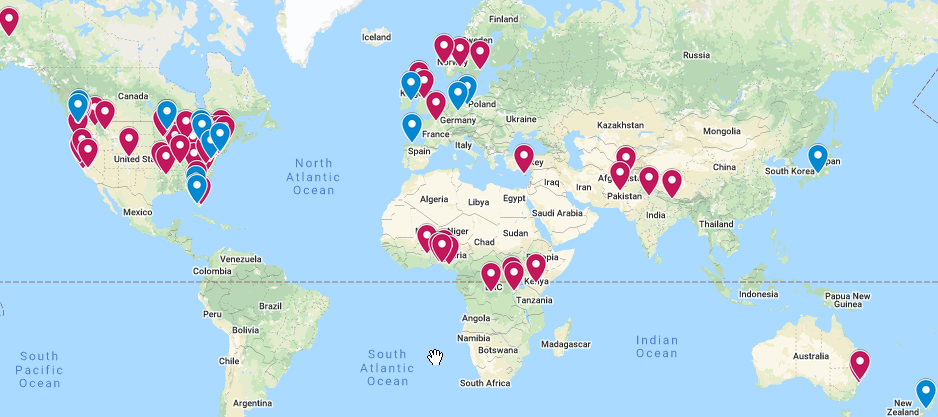Chapter 7anglesmr.'s Learning Website
- Chapter 7anglesmr.'s Learning Website Learning
- Chapter 7anglesmr.'s Learning Websites
- Chapter 7anglesmr.'s Learning Website Templates
- Chapter 7anglesmr.'s Learning Website Examples
By Doreen Virtue
I have been working with the angels for almost eight years now, and in fact, it was the Doreen Virtue book “Divine Guidance” that got me interested in working with the angels in the first place. Since then I have been a faithful fan, and have read almost every book that she has come out with. I even got to meet her at the Learning Light Center in Anaheim California back in 2001, and yes, she is just as nice in person as you’d think!
Angels 101, An Introduction to Connecting, Working, and Healing with the Angels, is an introductory book on working with the angels. In appearance this book is absolutely lovely. It’s smaller in size, and 122 pages in length (of course, a very angelic number). There are 10 chapters, and at the start of each chapter is a beautiful picture of an angel. The chapters themselves are each a different color of paper, and the paper is very thick and glossy.
The contents are as follows:
Introduction: Who are the angels?
Chapter 1: The Angelic Realm
Chapter 2: Connecting with your angels
Chapter 3: Signs from the angels
Chapter 4: Angelic protection
Chapter 5: Angels help us find what we’re looking for
Chapter 6: Angelic help with relationships
Chapter 7: Angelic help for your career and life purpose
Chapter 8: Healing with the angels
Chapter 9: Angels on earth
Chapter 10: Frequently asked questions about angels
In each chapter Doreen gives real life examples of encounters with the angels and then follows up with simple exercises on connecting with the angels. Her writing style is positive and flowing and very easy to read (I read this whole book on one afternoon!).
I also really like that Doreen doesn’t profess that you have to have been born as a clairvoyant to communicate with the angels, and clearly she believes that any of us, even the most psychically challenged, can communicate and connect with the angels. If you have ever been interested in working with the angels, but didn’t feel “psychic” enough or “special” enough, you will feel more confident in your abilities (or lack thereof) after reading this book.
I also recommend this book for more seasoned angel workers as it offers inspiration if we’ve been letting our spiritual side stagnate a bit. It may not offer any new information, but it does serve as a reminder that the Heavenly hosts are there for us and we should be connecting to them.
It would also serve as a great starter book for the teen in your life who may be interested in connecting with their angels.
For anyone who has ever been interested in working with the Angelic Realm, I would highly recommend “Angels 101.” It’s beautiful, fun and informative, and will make anyone feel more connected to their angels!
The Association offers Certifications, continuing education through our Online Learning Center (OLC), Educational Guidelines, networking through our Member Community, local Chapter events, the Journal of Forensic Nursing, and the International Conference on Forensic Nursing Science and Practice. The Association staff and volunteers welcome. The world's largest business referral organization is just a few clicks away. Find a business networking chapter near you to get started.
You Should Also Read:Talking to Angels
 Related Articles
Related ArticlesEditor's Picks Articles
Top Ten Articles
Previous Features
Site Map
Content copyright © 2021 by Deanna Joseph. All rights reserved.
This content was written by Deanna Joseph. If you wish to use this content in any manner, you need written permission. Contact Yvonnie DuBose for details.
Chapter 7anglesmr.'s Learning Website Learning
This chapter begins with descriptions of differing definitions of learning disabilities that include the views of specialists in learning disabilities as well as the IDEA definition. A history of the field of learning disabilities is presented as is information about the prevalence of learning disabilities. The etiology of learning disabilities is discussed as are learning, social, and emotional characteristics of individuals with learning disabilities. Assessments of students with learning disabilities and Response to Intervention (RTI) in terms of eligibility and classroom instructional strategies are included. The special needs of young children, adolescents, and adults with learning disabilities and their families are profiled. Diversity and full inclusion issues are raised. Useful assistive technology devices for individuals with learning disabilities are also presented.

Learning Objectives:
Chapter 7anglesmr.'s Learning Websites
- Summarize the key components of the IDEA definition of learning disabilities.
- Outline the four phases in the development of the field of learning disabilities.
- Identify possible causes of learning disabilities.
- List representative learning and social/emotional characteristics of individuals with learning disabilities.
- Explain the concept of response to intervention.
- Describe the following instructional approaches: cognitive training, direct instruction, and learning strategies.
- Summarize educational services for persons with learning disabilities across the life span.
Lecture Outline:
- Defining Learning Disabilities
- The term learning disability represents a fairly new concept- a disability that is not physically apparent and cannot be seen.
- In 1977, to comply with the Education for All Handicapped Children Act, a “specific learning disability” was determined to mean a disorder that manifest itself in children’s inability to perform certain tasks in specified ways. This disability excludes children who have other disabilities that contribute to their learning delays. This definition remained largely unchanged in later legislation. Current federal criteria for diagnosing a learning disability includes:
- Student does not achieve at expected age and ability levels when compared to age-level norms on standardized assessment measures
- Current IDEA definition
- A team determines that a severe discrepancy is present between a child’s actual levels of achievements and their potential for achievement in one or more of the following areas:
- Oral expression
- Listening comprehension
- Written expression
- Basic reading skill
- Reading comprehension
- Mathematics calculation
- Mathematic reasoning
- OR Student does not respond to Response to Intervention (RTI).
- The problems are not the result of sensory impairments, intellectual disability, emotional problems, environmental, cultural, or economic disadvantage (exclusionary clause).
- A team determines that a severe discrepancy is present between a child’s actual levels of achievements and their potential for achievement in one or more of the following areas:
- Association for Children with Learning Disabilities (Learning Disabilities Association of America) definition
- A Brief History of the Field
- Foundation Phase: Brain research conducted on adults with brain injuries
- Transition Phase: Scientific research applied to children’s learning
- Integration Phase: Legislation fostered educational changes based on research findings and introduced the new term learning disability in 1963.
- Current Phase: Educators face new challenges, and embrace new educational advances, to meet the needs of their students with learning disabilities
- Prevalence of Learning Disabilities
- The largest category in special education
- Gradual steady decrease in numbers of identified students in recent years
- More common in boys than girls
- Etiology of Learning Disabilities
- Acquired trauma to the central nervous system: Such as prenatal, perinatal, or postnatal injuries
- Genetic/hereditary influences: Family and twin studies seem to indicate that learning disabilities run in families
- Biochemical abnormalities: Current research does not support allergies or vitamin deficiencies as the cause of learning disabilities
- Environmental possibilities: Factors such as poverty, malnutrition, lack of access to health care and other factors may contribute to learning disabilities
- Characteristics of Individuals with Learning Disabilities
- A variety of characteristics that may impact:
- Language Skills (reading, writing, speaking)
- Mathematics skills
- Social and emotional factors
- Lifelong disability but may present itself differently at different ages
- A variety of characteristics that may impact:
- Assessment of Learning Disabilities
- IDEA requires a multidisciplinary evaluation to determine whether a student meets the criteria for a learning disability and specifies that:
- Tests are administered by trained professionals
- Tests are reliable and valid
- Tests are not discriminatory
- Tests are administered in the student’s native language
- A single measure cannot be used to determine eligibility
- States may opt to use a discrepancy model or a Response to Intervention (RTI) model for eligibility purposes.
- RTI is a fairly new concept that aims to keep students in the regular education classroom and provides intensive assistance.
- RTI is generally a process that increases the levels of instructional interventions provided in the regular education classroom.
- Students who do not meet with success with these intensive interventions may have a learning disability and are referred for formal assessment.
- Provides instructional support without waiting for a special education label.
- Assessment methods include:
- Norm-referenced assessment: An individual’s performance is compared to the performance of a normative group
- Criterion-referenced assessment: Measures a student’s ability to meet or master specific criteria
- Curriculum-based assessment: Assessment of the curriculum that the child has been taught
- Portfolio assessment: Displays student’s progress over a period of time
- IDEA requires a multidisciplinary evaluation to determine whether a student meets the criteria for a learning disability and specifies that:
- Educational Considerations
- Controversy about what the LRE is for students with learning disabilities even though many are placed in inclusive classrooms.
- Individualized instruction is most effective but three approaches are commonly used
- Cognitive training: Help students learn new ways to complete tasks and think about their learning
- Direct instruction: Teacher-directed lessons that provide step-by-step explicit instruction
- Mnemonic strategies: Aids with recall by creating an association that is easily remembered
- Learning strategies: Teach students how to find and learn new information
- Services for Young Children with Learning Disabilities
- Controversial to test for learning disabilities at this age due to variations in growth and development
- Label developmentally delay is often used for young children instead of learning disability.
- Curriculum models:
- Developmental/cognitive model
- Behavioral curriculum model
- Functional curriculum
- Transition into Adulthood
- Transition planning must occur via the IEP and must consider:
- Vocational training, preparation for post secondary education, employment possibilities, independent living, social skills, and self-determination skills.
- Transition planning must occur via the IEP and must consider:
- Adults with Learning Disabilities
- Learning disabilities impact independent living, employment, social relationships, and satisfaction with life.
- Supports and modifications needed for college and adult success
- Time management issues
- Organizational skills
- Self-discipline
- Self-advocacy
- Family Issues
- Families with a child with a learning disability may experience a wide range of concerns and often rely on a support network made up of friends and family members in addition to parent organizations and professional groups. Many organizations offer support for families of children with disabilities.
- Issues of Diversity
- Differentiating learning disabilities from cultural and linguistic differences
- Evidence of disproportionate representation in certain racial/ethnic groups
- Technology and Individuals with Learning Disabilities
- Assistive technology can help with learning efficiency and effectiveness
- Content area learning
Chapter 7anglesmr.'s Learning Website Templates
Assistance with memory issues
Chapter 7anglesmr.'s Learning Website Examples
- Trends, Issues, and Controversies
- Full Inclusion Movement
- Inclusion is a controversial concept and many professionals have strong beliefs about inclusion or segregated educational practices for students with disabilities.
- Data do not support that full inclusion is the best placement for students with learning disabilities
- Full Inclusion Movement

